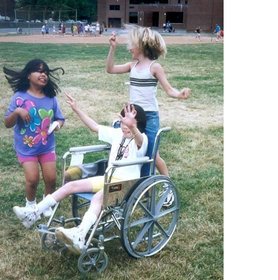- English-only slideshow
- Handouts for Participants in English and in Spanish
- A CPIR “Highly Rated” resource
Module 15 pivots on a point of enormous importance in the educations of children with disabilities under IDEA: They are to be educated in the least restrictive environment (LRE), learning and working alongside their peers without disabilities to the maximum extent appropriate. Learn how the concept of LRE (and IDEA’s requirements) influences decision making about children’s placement and what resources and tools exist to support their education in the regular education classroom.
Editor’s note–January 2018 | While this module was originally produced in 2008, the information provided about least restrictive environment (LRE) and decision making is still accurate. The process covered in the law (IDEA) has not changed since this module was written. What’s most likely out of date as of January 2018 will be the many references to resources of further information or assistance on the subject of making decisions about a child’s LRE.
Just looking for a quick summary?
If you’re merely looking for a quick summary of LRE and placement, not the detailed explanation that Module 15 offers, we are pleased to direct you to just such: Placement, Short and Sweet
__________________________
Module 15 is available in English only (except for the handouts for participants, which are also available in Spanish). The module includes:
- a slideshow presentation;
- a Trainer’s Guide; and
- handouts for participants in English and in Spanish.
Please help yourself below, and download the components you need to learn on your own and/or to train others regarding children’s placements are determined according to IDEA’s LRE principles.
Component #1: The Slideshow
English only
These 15 full-color slides tell the story of LRE.
- Slideshow for Module 15 (in a ZIP folder)
Component #2: Trainer’s Guide to the Content
This guide to Module 15 is in English but should also be downloaded if you’re training in Spanish. That’s because here is where you’ll find the full explanation of each slide’s content. It also offers much additional info so that trainers can adapt training sessions to a length or detail suitable to the given audience.
Word | Complete Guide (Accessible Word file)
Component #3: Handouts for Participants | Folletos para Participants **
In English and in Spanish
The handouts for Module 15 are included in a packet of handouts designed to cover the entire umbrella topic of Theme D, the Individualized Education Program. If you’ve downloaded the handouts for Theme D already (for example, as part of training on Modules 12, 13, 14, or 16), you have the handouts you need for Module 15. If you haven’t downloaded any handouts for Theme D yet, here they are in 2 different formats and 2 different languages.
Handouts in English
PDF | English Handouts for Theme D
Word | English Handouts for Theme D (Accessible Word file)
Handouts in Spanish | Folletos en Español **
Word | Los Folletos para Tema D (en archivo accesible)
Note about the Spanish Translations:
In preparing the handouts in Spanish, NICHCY (the producer) chose to use a certain vocabulary set for the terminology most frequently used in IDEA. IDEA itself is extremely and purposefully consistent about its terminology, and we felt it critical to do the same in Spanish. However, we fully recognize that there are many ways to say the same thing, and Spanish is rich with alternatives from country to country, region to region. So we’ve also prepared a glossary of the terminology used in IDEA, how we’ve rendered that terminology in Spanish, and other ways of rendering it that families may also hear. Share this with participants as you see fit or use it to guide your own translations. The glossary of terminology is available in two formats, PDF and Word:
There! You’re all set to go for Module 15.
Please remember that these materials are designed to be a thorough and authoritative source of info on the principles of LRE under IDEA 2004 and how placements decisions are to be made with LRE guiding the way. That’s why they are so detailed. As a trainer, you are free to adapt the info we’ve offered to serve the purposes and needs of your audiences and the amount of time you have to spend with them.
Back to top
________________________________________________________
**Highly Rated Resource! This resource was reviewed by 3-member panels of Parent Center staff working independently from one another to rate the quality, relevance, and usefulness of CPIR resources. This resource was found to be of “High Quality, High Relevance, High Usefulness” to Parent Centers.
________________________________________
Quick-Jump Menu to Other Modules
1: Top 10 Basics of Special Education
2: Key Changes in IDEA
5: Disproportionality and Overrepresentation
6: Early Intervening Services and Response to Intervention
7:Highly Qualified Teachers (withdrawn with the reauthorization of NCLB as the ESSA in 2015)
8: NIMAS
9: Introduction to Evaluation under IDEA
10: Initial Evaluation and Reevaluation
11: Identification of Children with Specific Learning Disabilities
12: The IEP Team
13: Content of the IEP
14: Meetings of the IEP Team
15: LRE Decision Making (you’re already here)
16: Children Enrolled by Their Parents in Private Schools
17: Introduction to Procedural Safeguards
18: Options for Dispute Resolution
19: Key Issues in Discipline


